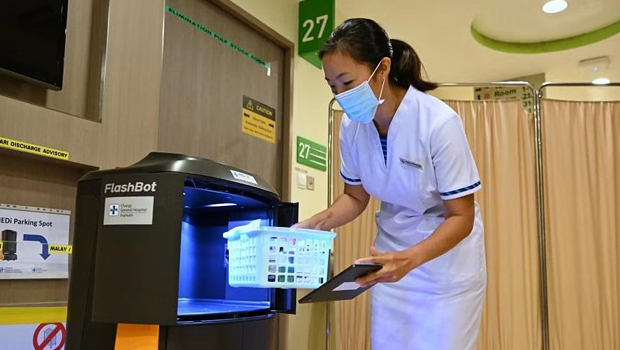
MEDi, or Medication Delivery innovation, can deliver up to four baskets of drugs to four different locations in the ED. ST PHOTO: CHONG JUN LIANG
Sporting staff badges and an infectious smile, a trio of robots joined the emergency department (ED) at Changi General Hospital (CGH) in April.
CGH said on Friday that MEDi, EDi and BLANKi – as the robots are called – help with medicine delivery from pharmacists to nurses, guide patients around the ED and distribute blankets to visitors, giving nurses some much-needed assistance with their heavy workload.
The autonomous mobile robots (AMR) range from 1m to 1.3m in height, and are part of a trial to measure the increase in efficiency and productivity in the nurses’ workflow in the ED.
They are equipped with sensors, speakers and a touchscreen display, allowing them to communicate with patients and weave through the complex ED environment without causing accidents.
The hospital follows in the footsteps of other organisations and institutions here who have started using robots to assist with repetitive, manual tasks.
The Singapore Police Force recently rolled out patrol robots at Changi Airport Terminal 4, while SIA Engineering has adopted robots to assist technicians in inspecting aircraft.
Robots that will help clean and inspect Singapore’s rivers are also expected to be deployed in the near future.
The three AMRs at CGH are the most recent additions to the hospital’s robotic crew of more than 80 machines.
MEDi, or Medication Delivery innovation, can deliver up to four baskets of drugs to four different locations in the ED.
Nurses use a tablet to submit medicine requisition forms to the pharmacist, who then places the medicine in the AMR before selecting its target destination on the screen, triggering the bot to navigate to a station near the nurse.
The black-and-orange MEDi saves ED nurses a lot of time and walking by completing up to 16 drug retrieval and dispatch rounds daily.
Previously, nurses had to walk for about seven minutes between the pharmacy and ED to collect patient prescriptions each time.
“With MEDi, the ED Pharmacy can better support our nurses as we receive the medication request forms earlier and quicker,” the hospital said on Friday.
CGH added: “Our ED nurses and porters also no longer need to leave their stations for extended periods of time and can focus on patient care.”

EDi is also programmed to speak the nation’s four official languages, making it user-friendly for the Republic’s diverse demographic. ST PHOTO: CHONG JUN LIANG
Robotic navigator EDi, or Emergency Department innovation, ushers patients and their accompanying next-of-kin to their intended destinations, saving nurses four minutes of guiding, which amounts to around 1½ hours a day.
EDi is also programmed to speak the nation’s four official languages, making it user-friendly for the Republic’s diverse demographic.
The final member of the trio is BLANKi, or Blanket Delivery innovation, whose wider frame is fitted with three shelves to carry blankets for ED visitors.
While it roams around the waiting area, patients can pick up a blanket from BLANKi conveniently by touching its screen to stop it from cruising.
BLANKi works alongside CGH service ambassadors and handles around 50 per cent of blanket deliveries.

BLANKi, or Blanket Delivery innovation, is fitted with three shelves to carry blankets for ED visitors. ST PHOTO: CHONG JUN LIANG
“Instead of showing (patients) where to collect the blanket, we decided to bring the blanket to them,” said Mr Edward Fung, CGH service ambassador.
He added: “We receive many requests for blankets in a day, and wanted a more efficient way to bring the blankets to patients and visitors.”
The trial of the robot trio will conclude in August.
The hospital is looking to stock BLANKi with other items such as bottled water, while EDi and MEDi could potentially be used beyond the ED in other areas of the hospital as well.
Get updates on Tomorrow's Medicine in your mailbox!













 Get it on Google Play
Get it on Google Play